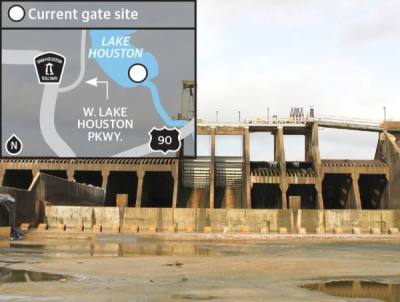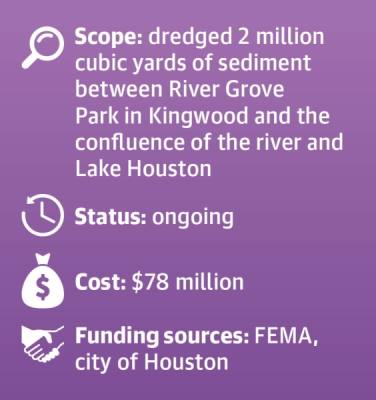City Council Member Dave Martin said he believes the ongoing Lake Houston dam gate project is going to be a major project for residents upstream and downstream of the Lake Houston dam. Designs and engineering for the dam gates will begin this spring.
“My opinion is [the gate project is] the single most important project for Lake Houston,” Martin said.
Additionally, the city of Houston—as the primary owner of Lake Houston—plans to kick off long-term dredging initiatives in the Lake Houston area to reduce flooding and increase the reservoir’s capacity, Martin said.
Even before Hurricane Harvey hit the region in August 2017, Lake Houston’s capacity to hold water had decreased more than 20% since the lake’s dam was built in 1954 from 158,553 acre-feet to 124,661 acre-feet in 2011, according to a 2011 report on Lake Houston’s sediment from the Texas Water Development Board.
Although the Army Corps of Engineers Galveston District has already removed more than 2 million cubic yards of sediment from the West Fork of the San Jacinto River, the city—in partnership with the Harris County Flood Control District and Coastal Water Authority—plans to continually dredge Lake Houston, Martin said.
“We will have beginning 2020 an ongoing Lake Houston maintenance program that will be 365 [days a year], 7 days a week, 24 hours a day dredging in Lake Houston, San Jacinto River and in all the tributaries ... in and around Lake Houston,” he said.
Engineering dam gates
During Harvey, water was released from the Lake Conroe dam, which is upstream from Lake Houston, at a peak rate of about 79,000 cubic feet of water per second, Community Impact Newspaper previously reported.Meanwhile, Lake Houston’s dam gates, which are made to release water at a rate of only 10,000 cubic feet per second, discharged water at 425,000 cubic feet per second during Harvey, according to a February 2018 report from Harris County and consulting firm Freese and Nichols.
“Everybody knows it flooded in Kingwood and on the lake, but most people don’t know ... [it] went through and bypassed the dam and flooded ... other stuff,” Harris County County Engineer John Blount said.
In August, the Federal Emergency Management Agency approved the city of Houston’s project to build $47.1 million gates on the Lake Houston dam. FEMA will fund most of the project, while the local match will be funded by the city of Houston, the Harris County Flood Control District and the state of Texas’ Rainy Day Fund, Houston Chief Recovery Officer Stephen Costello said.
Costello said the additional gates will allow water to be released more quickly from the dam in rainstorms to lower water levels upstream to prevent flooding while also preventing any adverse effects downstream.
The city aims to finish the project by August 2022, he said.
While the preliminary design plan was to build 10 gates directly next to the four existing gates, Costello said the city is now considering constructing gates away from the spillway.
“Because of the age of the dam—the integrity of the dam—maybe there’s a possibility of putting the gates in a different location in close proximity to the existing gates,” he said.
However, Costello said the gate location will be determined by engineering consultants the city will hire in February or March. Final designs should be completed in August before they are submitted to FEMA for final approval.
Long-term dredging
To combat Lake Houston’s decreasing capacity and reduce flooding, officials said long-term dredging projects are also a priority.Most recently, Costello said the city of Houston submitted a new dredging project into FEMA’s grant portal in late September for permission to dredge 1 million cubic yards from north of the mouth bar, or the accumulation of sediment at the confluence of Lake Houston and the West Fork of the San Jacinto River.
Additionally, the city of Houston will begin a project in mid-January to dredge from the mouth bar; however, the amount of sediment that will be removed has not been determined, Costello said.
Both projects will be partially funded by the remaining $6 million from a $50 million grant from Gov. Greg Abbott’s office as well as $30 million granted to Harris County to dredge the Lake Houston area via Senate Bill 500, Costello said. The bill passed during the 86th Texas legislative session last year.
Blount’s office received approval to apply for the $30 million from the Texas Water Development Board at the Harris County Commissioners Court meeting Dec. 17.
Costello said the city has also decided to hire a dredging company to begin long-term dredging operations to the Lake Houston area, which will be partially funded by SB 500. He said a plan will need to be created to determine which areas will be dredged.
Meanwhile, the San Jacinto River Authority and the Harris County Flood Control District are negotiating a scope of work with consultants to find solutions for sediment that accumulates in the river and lake.
Chuck Gilman, the SJRA’s director of flood management, said he plans to get the SJRA’s approval in February for an interlocal partnership with the flood control district to fund a sediment study, which could cost about $400,000. He said the study could begin in the spring and take 10-12 months to complete.
“We want to know what do we need to study and want to study to help answer the question of where [the sediment is] coming from, where it’s being deposited and what can be done about it,” Gilman said.










